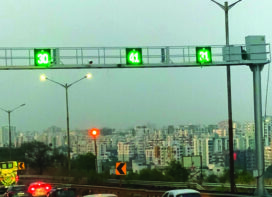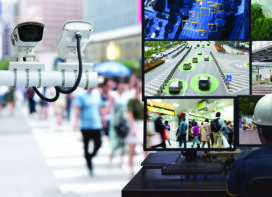 With the exponential growth in the number of vehicles on Indian roads, the transport planners and operators are concentrating increasingly on better roads, more fuel efficient vehicles, better traffic management, enhanced public transport systems and improved quality-related infrastructure. One area that causes much aggravation but has received less attention is parking. Searching for safe, available, affordable parking is a tiring exercise that, through frayed nerves, also leads to loss of productivity.
With the exponential growth in the number of vehicles on Indian roads, the transport planners and operators are concentrating increasingly on better roads, more fuel efficient vehicles, better traffic management, enhanced public transport systems and improved quality-related infrastructure. One area that causes much aggravation but has received less attention is parking. Searching for safe, available, affordable parking is a tiring exercise that, through frayed nerves, also leads to loss of productivity.
While the thrust to improve the usage of public transportation will continue, the need for provision of off-road and on-road parking facilities for private vehicles cannot be ignored during the process of intelligent planning. Whether it is the local municipal authorities or privately managed malls, multiplexes, airports or corporations, efficient parking provision and management pose significant but varied challenges.
Multiple requirements need to be considered for providing a complete parking solution. While planning the parking services, it is not just the need of the final user that has to be kept in mind but the point of view of the builder and the owner or operator of the system too has to be taken into account. For constructing and providing a good parking system, the ease of construction and implementation, cost-effectiveness, ease of procurement, and ease of integration of the multiple components are of great importance to the builder. For the owner / operator or maintenance group, maximising the parking capacity, reliability of systems & components, post-sale service quality and speed, cost of upkeep, ease of operations and maintenance and ease of revenue accounting are of utmost importance. As against these, the primary considerations of the end user are the time & ease of finding a vacant spot, effortlessness of navigating in and out, safety to vehicle & the occupants and the price.
Various products that fit into this product space include Parking Systems, Parking Guidance Systems, Access Control Systems, Pay and Park Systems, Information Display Signs and Safety Enhancing Products.
Globally, a number of players exist in each of these product segments. The challenge is in finding the right product for your specific needs at the right price, getting a complete understanding of the total cost of ownership of the product, coordinating between the multiple vendors to ensure smooth integration & timely completion, and managing the after-sales scenario by getting timely and cost-effective service on an on-going basis.
Dealing with companies that have a wide-ranging product portfolio within the parking solutions space, integration skills, local presence and a good service set-up make the task of a builder or operator much simple.
Parking Guidance Systems
In India parking is still largely manually controlled. But this scenario is undergoing change and it is a matter of time before technology makes its presence felt not just in commercial private property but in on-road parking as well. An effective parking system has, at its heart, an intelligent guidance system that helps locate vacant spots and navigate in and out of them easily. This is achieved through the use of a series of informative panels, sensors, pilot lights, pass counters and management software.
 Manual parking guidance poses a number of challenges. From a motorist’s perspective: Driving around the parking area’s aisles to locate a free spot; wasting time and gas while searching for a spot (especially during peak traffic hours); and getting in stressful situations that could lead to an accident. From a parking manager’s perspective: The parking area may always indicate the sign “full” when few spots are still vacant which, then, may be left unused; during peak traffic hours, the parking area may be congested and may require personnel to guide traffic; even when no spots are vacant, car drivers, unaware of the situation, might still be going around in the parking area looking for space; assessing the parking situation at all times will be a difficult task; and, it will always be difficult to evaluate if a car has been parked at a spot for a long time (this becomes important in case of robbed or abandoned cars).
Manual parking guidance poses a number of challenges. From a motorist’s perspective: Driving around the parking area’s aisles to locate a free spot; wasting time and gas while searching for a spot (especially during peak traffic hours); and getting in stressful situations that could lead to an accident. From a parking manager’s perspective: The parking area may always indicate the sign “full” when few spots are still vacant which, then, may be left unused; during peak traffic hours, the parking area may be congested and may require personnel to guide traffic; even when no spots are vacant, car drivers, unaware of the situation, might still be going around in the parking area looking for space; assessing the parking situation at all times will be a difficult task; and, it will always be difficult to evaluate if a car has been parked at a spot for a long time (this becomes important in case of robbed or abandoned cars).
Parking management systems today are able to direct customers to the nearest parking areas with vacant slots using GPS and mobile/internet connectivity. Once at location, there is a signage indicating available slot positions and overall occupancy. These signs are automatically updated with the help of sensors at parking spots and integration software. The software enables operators to get a consolidated view of the entire parking area and the reporting enables them to open/close areas depending on need, switch the lighting on or off; and heat/cool the unused zones, thus reducing costs of operation.
Access control barriers ensure secure ingress and egress only to authorised personnel and vehicles. These work variously on Access cards, Tokens or even LPR (Licence Plate Recognition) systems. They can be configured to segregate special parking zones for aged, physically challenged or other special categories of users. In addition to LPR, radio frequency identification (RFID) tags, bar code tags, and transponders are also used to identify vehicles. On-street technologies used to enforce parking restrictions include handheld units and in-ground sensors that can detect how long a vehicle has occupied a space.
Parking Guidance Systems, in consonance with other components such as parking meters, access systems and safety systems lead to an enhanced experience for all concerned – drivers, builders, owners and operators!
Automated Guidance Systems
 The basic advantages of an automated parking guidance system include: Rapid and easy installation; reduction of the energy bill through the use of thermal maps and intelligent allocations; easier access, reduced time spent looking for parking space, reduced frustration and reduced energy spending for drivers; and increased space occupancy and associated increase in revenue for car park operators. Avoidance of possible jams, easier management & real-time operation, more efficient use of the personnel, reduced pollution in the car park, and Increased revenue by better space utilisation & increased rotation are its other benefits.
The basic advantages of an automated parking guidance system include: Rapid and easy installation; reduction of the energy bill through the use of thermal maps and intelligent allocations; easier access, reduced time spent looking for parking space, reduced frustration and reduced energy spending for drivers; and increased space occupancy and associated increase in revenue for car park operators. Avoidance of possible jams, easier management & real-time operation, more efficient use of the personnel, reduced pollution in the car park, and Increased revenue by better space utilisation & increased rotation are its other benefits.
Automated Parking Systems / Mechanised Parking Solutions are very popular in Japan and are seeing increasing traction elsewhere. They remove the driver from the process of parking and in doing so, also do away with ramps, driveways, elevators, stairways, etc., thus reducing the infrastructure investment and maximising the space utilisation. In these systems, the driver parks the vehicle at a designated spot and, through use of automated mechanised systems, the vehicle is moved to a vacant spot in the multi-storey parking facility. While exiting, the user swipes the ticket issued at entry and the vehicle is brought to the exit bay.
Parking revenue control systems are becoming increasingly sophisticated and payment options are being expanded. Some systems in use around the world are parking meters that accept coins depending on duration and location & visually indicate over-stay; scratch cards that are pre-purchased and displayed on the windshield; pay and display machines that issue tickets to be displayed & accept payment through coins, smart cards, credit cards and nowadays, even through mobile phones. Then there are systems like ‘EasyPay’ that use in-vehicle meters integrating computer and communication technologies that can be topped up at convenience, turned on while parking after choosing city and location, displayed for enforcers & then turned off while leaving the parking area. Tel Aviv, Berlin, Sydney and many other cities follow mobile parking solutions – where registered mobile devices are used to purchase & pay for parking using SMS / IVR facilities, and GPS or location based services of the telecom provider are used to determine the tariff. Many of the newer payment technologies allow for dynamic tariff options – for different parking zones or demographic groups (e.g. pensioners, physically challenged drivers and so on).
Further developments in mechanised parking are working towards making dismantle-able, stacked parking structures to reduce investment and increase flexibility as well as better algorithms to increase the speed of storage and retrieval in the stacks. Today, ‘puzzle’ parking structures that work with minimal vacant slots too are being adopted, thus increasing space utilisation. These new technologies not only benefit the driver in terms of ease of parking and payment but also benefit the traffic planners, facility operators and even the parking enforcement authorities to help locate abandoned / stolen vehicles, traffic violators and even reduce parking payment defaulters.
As India moves towards making its infrastructure comparable to the best in the world, we can expect to see many of these developments in our cities too!
 Vinay Jain, Managing Director
MassTrans Systems(P) Ltd
Vinay Jain, Managing Director
MassTrans Systems(P) Ltd
 TrafficInfraTech Magazine Linking People Places & Progress
TrafficInfraTech Magazine Linking People Places & Progress


